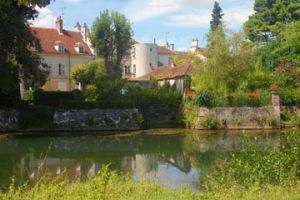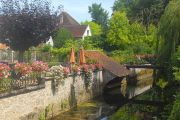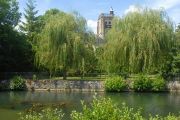 |

|
 Crécy-la-Chapelle © T. Joly Crécy-la-Chapelle © T. Joly

|
At the turn of the 20th century the lovely and peaceful Grand Morin valley proved especially attractive to many painters. Nearly a century later it retains most of its former charm as well as picturesque villages and a path follows in the artists’ footsteps.
[ Practical ]
Getting there
- By road
47 km from Paris on autoroute A4 till exit 16, then on D934 till Crécy-la-Chapelle.
- By train
Train from Paris Gare de l’Est to Meaux till Esbly, then connecting train going to Villiers-Morin and Crécy-la-Chapelle. The journey takes about 55 minutes.
Lodging
- Hôtels
Domaine de la Brie
Auberge du Souterrain
- Bed and breakfast
Les Bergenias in Crécy
Le Moulin de Saint Martin in Voulangis
Castel Morin in Villiers-Morin
Restaurants
Domaine de la Brie
Auberge du Souterrain
La Cabane
La Table du Curé
Canoe and mountain bike rentals
Loc’ Adventure
Tel : 0164170400
www.locadventure.com
Hiking with a donkey
Randos’Anes
Tel : 0607879784
www.randos-anes.com
Golf
Domaine de la Brie
Tel : 0164753434
www.domainedelabrie.com
Information
- Seine et Marne tourist office
Tel : 0160396039
www.tourisme77.com
- Pays Créçois tourist office
1 place du Marché, 77580 Crécy-la-Chapelle
Tel : 0164637019
www.cc-payscrecois.fr
During the second half of the 19th century, thanks to the invention of the paint tube, artists left more and more often their studios to set up their easel in open air. Looking for natural landscapes and good luminosity, they ventured outside Paris and founded a number of rural art colonies in several Ile-de-France villages preserved from the industrial revolution and easily accessible by train.

 Crécy-la-Chapelle © T.Joly Crécy-la-Chapelle © T.Joly
|
 Van Gogh and Toulouse-Lautrec Van Gogh and Toulouse-Lautrec
Barbizon and Auvers-sur-Oise are the most famous of these places but there were many others like the Vallée du Grand Morin. Located 45 km East of the capital, in the Brie, shortly before Meaux, it was discovered in 1857 by painter Amédée Servin who was seduced by the beauty of this river, the hilly agricultural landscapes of the surroundings and the traditional architecture of the villages. He was soon joined by other painters. They were academic artists and members of the Barbizon school such as Paul Baudry, Jacques Henner, Eugène Decan and Henri Ostolle-Delage. They set up in Saint-Germain-sur-Morin, Crécy-la-Chapelle and Villiers-Morin where Amédée Servin created an artistic circle. Vincent Van Gogh, Henri de Toulouse-Lautrec, Suzanne Valadon and Emile Bernard also came there on the invitation of painter Albert Grenier and his wife, former model Amélie Sans, who were organizing meetings and Parisian parties in their house in Villiers.

 Crécy-la-Chapelle © T.Joly Crécy-la-Chapelle © T.Joly
|
 Foreign artists Foreign artists
Then, in the early 20th century the valley was home to artists belonging to the Nabis and Fauves movements including André Derain and André Dunoyer de Segonzac. Along them figured some foreign artists. Canadian Emily Carr, Américan Arthur B. Carles and Japanese Yuzo Saeki and Henry Sugimoto. Lastly, American painter and photographer Edward Steichen lived in the hamlet of Voulangis where he welcomed his friends Man Ray and Constantin Brancusi.
Nearly a century later, the valley hasn’t lost any of its charm. The best way to discover it is to stroll along a walking path recently created that runs from Crécy-la-Chapelle to Saint-Germain-sur-Morin passing by Villliers and several little hamlets. 11,5 km long, it follows in these artists’ footsteps and allows finding the places that inspired them. Except from the fact that the path is sometimes a bit difficult to find this ramble is very easy. It is punctuated with bilingual illustrated boards telling the story of the artists in the valley and showing pictures of the canvases made on the exact spots where they stand.
 The Venice of the Brie The Venice of the Brie
A peaceful river, shady banks, cereal fields and meadows where horses and cows are grazing give the feeling of being very far away from Paris. Only the modern houses bearing the same aspect built by commuters on the outskirts of the villages remind you of the proximity of the capital. Fortunately the historical centres haven’t changed a lot. Particularly in Crécy-la-Chapelle and Villiers-Morin where most of the painters lived and worked. These two villages can easily be visited in one day even if you don’t want to do the hike and don’t have a car because they are both situated on the same railway line.
Called the Venice of the Brie, Crécy-la-Chapelle is crisscrossed by waterways lined with numerous washhouses. They are either branches of the river Grand Morin or former moats once dug along the ramparts and that are now filled with water. Moreover, many remains of the fortifications that encircled the town in the past are visible.

 Crécy-la-Chapelle © T.Joly Crécy-la-Chapelle © T.Joly
|
 Canoeing on the waterways Canoeing on the waterways
Its consists of stretches of wall, defensive towers and the gate standing at the beginning of the road leading to Meaux that is topped with a belfry since the 19th century. In addition, there is still a section of a 12th century sentry path that leads near the house where painter Corot lived for a while. There are also numerous bridges. All of them offer nice views over the waterways, ancient mills, former tanneries and monuments such as the 18th century church of Saint-Georges that seems as being completely surrounded by weeping willows when seen from the bank of the river. Along the peaceful streets you can also find a few nice private mansions, like the one housing the city hall, and slightly outside the village stands the beautiful Collegiale church Notre Dame de l’Assomption built between the 12th and 15th centuries. If you wish, you can canoe on the waterways. It’s a very enjoyable way to wander around and it gives another vision of Crécy.
 Rustic houses Rustic houses
Many simple looking houses indeed hide behind their façade beautiful gardens and terraces extending till the edge of the canals.
Six kilometres away, Villiers-Morin is an equally pleasant and relaxing place but it has a totally different look. Indeed, this village is not surrounded by water and is not only built along the river Grand Morin where there are some elegant villas. Its historical centre is located on the slope of the valley. That’s where stands the church Yuzo Saeki painted from all angles within few days in 1928. Streets leading up hill are sometimes very steep and lined with less smart and more rustic houses. There are even farms and meadows almost in the centre. A small stream running downhill and winding through houses and monuments adds to the feeling to be in the countryside. Paris seems to be even further away than in Crécy. One easily understands why so many artists fell under the charm of the Grand Morin valley.
September 02, 2009
Thierry Joly 

|



